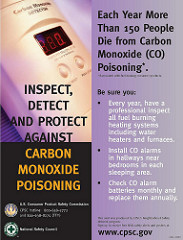Carbon Monoxide Toxicity
Production of Carbon Monoxide
Carbon Monoxide is produced by the incomplete combustion of substances that contain carbon. This is usually the case when fuel is burned without a proper ventilation system to supply the needed amount of oxygen. In the absence of sufficient oxygen, carbon-containing substances will burn, but the carbon combines with one oxygen atom instead of two oxygen atoms. This process prevents the formation of carbon dioxide, instead, yielding carbon monoxide.
Toxicity Of The Gas
Carbon monoxide is toxic to all hemoglobic animals and not just humans. These rely on hemoglobin to transport oxygen to the various tissues around the body. When the gas is inhaled, it combines with the hemoglobin to form a compound known as carboxyhemoglobin. This compound reduces the effectiveness of the oxygen-carrying hemoglobin to transfer oxygen from the lungs to the various parts of the body.
When one inhales a concentration of carbon monoxide that 35 parts-per-million (ppm), toxicity ensures. Increasing concentration of the gas produces devastating effects to one’s health. At high levels of concentration, as much as 50% of the body’s hemoglobin can be converted to carboxyhemoglobin. This poses a health risk as it causes physiological health issues. These can include seizures, coma or even death.
 The onset of carbon monoxide poisoning is marked by the occurrence of headaches, disorientation, confusion, vomiting, fatigue, dizziness, and nausea. What exacerbates the danger of the gas is its insidious nature: it is odorless, tasteless and colorless. This makes its detection by humans virtually impossible.
The onset of carbon monoxide poisoning is marked by the occurrence of headaches, disorientation, confusion, vomiting, fatigue, dizziness, and nausea. What exacerbates the danger of the gas is its insidious nature: it is odorless, tasteless and colorless. This makes its detection by humans virtually impossible.
The long-term effect of carbon monoxide poisoning includes damage to the cardiovascular system and/or damage to the nervous system.
Prevention Of Toxic Exposure To This Gas
The only sure way to prevent toxic exposure to carbon monoxide is to burn carbon-containing substances in environments with proper ventilation and an ample supply of oxygen. It is also a wise precaution to have carbon monoxide detectors in the house – these are often incorporated into smoke detectors.
Ready to Get Started?
To learn more about our Environmental Testing Services
click below, or contact us at (509) 720-0190
